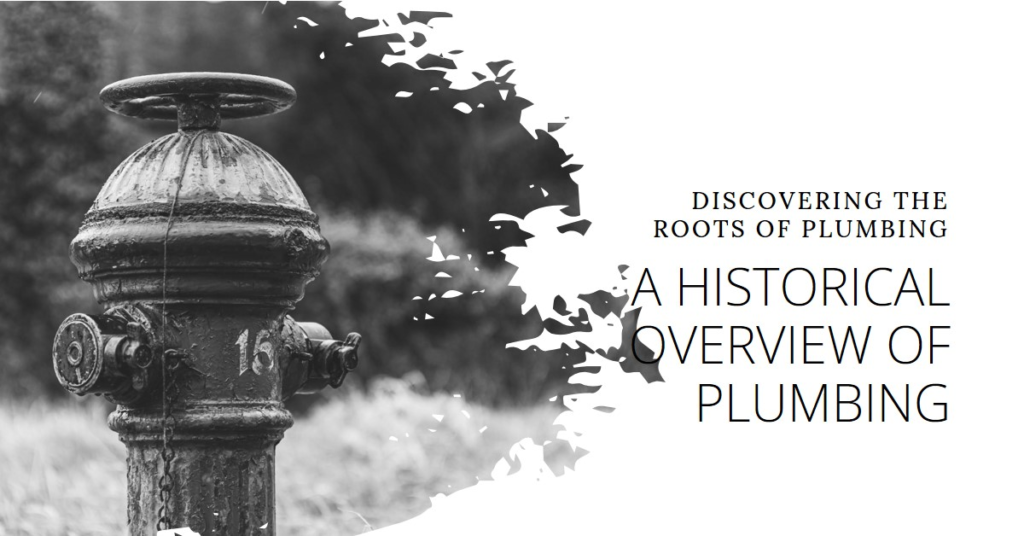
Table of Contents
- Introduction:
- Egyptian Ingenuity: Water Management in the Land of Pharaohs
- Roman Grandeur: The Pinnacle of Ancient Plumbing
- Medieval Plumbing: The Dark Ages and Beyond
- Renaissance Revival: Plumbing Reawakens
- Industrial Revolution: The Birth of Modern Plumbing
- 20th Century Innovations: Plumbing in the Modern Age
- Plumbing Today: Sustainable and Smart Solutions
- The Future of Plumbing: Innovations on the Horizon
- Conclusion: Plumbing’s Legacy and Ongoing Impact
Introduction:
Plumbing, an integral aspect of modern infrastructure, has its roots in ancient civilizations. The earliest evidence of plumbing dates back to around 4000-3000 BCE in the Indus Valley Civilization. Archaeologists have unearthed complex systems of drainage and water supply in the cities of Harappa and Mohenjo-Daro, showcasing advanced engineering for that era.
In these ancient cities, houses were equipped with bathrooms, and the streets featured well-planned sewer systems. These innovations not only reflect the ingenuity of the Indus Valley engineers but also highlight the importance of sanitation and water management in early human societies.
Egyptian Ingenuity: Water Management in the Land of Pharaohs
As we move forward in time, the ancient Egyptians made significant strides in plumbing. They developed intricate irrigation systems along the Nile River, ensuring a consistent water supply for agriculture and daily use. The Egyptians also constructed the first known copper pipes to transport water, marking a pivotal moment in the history of plumbing technology.
The temples and palaces of Egypt were equipped with lavatories and bathrooms, indicating a sophisticated understanding of hygiene. The pyramids, too, had complex systems to manage water flow, further emphasizing the advanced state of Egyptian plumbing.
Roman Grandeur: The Pinnacle of Ancient Plumbing
The Romans are often celebrated as the pioneers of sophisticated plumbing systems. Around 500 BCE, they began constructing aqueducts, vast networks that transported water from distant sources into cities and towns. These aqueducts, some spanning over 50 miles, utilized gravity to maintain a steady flow of water.
Roman cities featured public baths, fountains, and latrines, all connected by an extensive system of lead and clay pipes. The Cloaca Maxima, one of the world’s earliest sewage systems, efficiently managed waste in Rome. These innovations not only improved public health but also set the standard for future plumbing systems.
Medieval Plumbing: The Dark Ages and Beyond
The fall of the Roman Empire led to a decline in plumbing advancements in Europe. During the Medieval period, sanitation practices deteriorated, and much of the Roman plumbing knowledge was lost. However, some monasteries and castles maintained rudimentary plumbing systems, with stone troughs and aqueducts providing basic water supply and drainage.
In contrast, the Islamic Golden Age saw significant progress in plumbing technology. Scholars and engineers in the Middle East and North Africa built upon Roman innovations, developing sophisticated systems for irrigation, bathing, and sewage disposal. Cities like Baghdad and Cordoba featured public baths and extensive water supply networks, reflecting a high level of urban planning.
Renaissance Revival: Plumbing Reawakens
The Renaissance period marked a resurgence in scientific inquiry and engineering. Plumbing innovations began to re-emerge, influenced by classical Roman designs. In the 16th century, Leonardo da Vinci designed complex water systems, including canals and pumps, although many of his ideas were not realized in his lifetime.
During this time, European cities started to construct more organized water supply and sewage systems. The introduction of cast iron pipes in the late 17th century improved the durability and efficiency of plumbing infrastructure, paving the way for modern plumbing developments.
Industrial Revolution: The Birth of Modern Plumbing
The Industrial Revolution of the 18th and 19th centuries brought about a dramatic transformation in plumbing technology. Rapid urbanization necessitated the development of comprehensive water supply and sewage systems to support growing populations. Engineers began using steam engines and pumps to manage water flow, leading to the construction of large-scale waterworks.
In the 19th century, cities like London and New York faced severe public health crises due to poor sanitation. The introduction of flush toilets, combined with improved sewage systems, significantly reduced the spread of diseases such as cholera. Innovations like the S-bend trap, invented by Thomas Crapper, helped prevent sewer gases from entering homes, further enhancing public health.


20th Century Innovations: Plumbing in the Modern Age
The 20th century witnessed a plethora of advancements in plumbing technology. The widespread adoption of indoor plumbing revolutionized daily life, providing households with reliable access to clean water and efficient waste disposal. Materials like copper and PVC replaced cast iron and lead, offering greater flexibility and safety in plumbing installations.
The development of water heaters, dishwashers, and washing machines further integrated plumbing into daily routines, enhancing convenience and quality of life. Municipal water treatment facilities became standard, ensuring the delivery of safe drinking water to urban and rural areas alike.
Plumbing Today: Sustainable and Smart Solutions
In the 21st century, plumbing continues to evolve, driven by sustainability and smart technology. Modern plumbing systems prioritize water conservation, with innovations such as low-flow fixtures, dual-flush toilets, and rainwater harvesting systems. These advancements help reduce water consumption and minimize environmental impact.
Smart plumbing solutions, including leak detection sensors and automated water management systems, enhance efficiency and prevent costly damage. Additionally, green plumbing practices, such as the use of greywater systems for irrigation, promote sustainable water use in residential and commercial settings.
The Future of Plumbing: Innovations on the Horizon
Looking ahead, the future of plumbing promises even more exciting developments. Advances in materials science may lead to the creation of self-healing pipes and more durable, eco-friendly materials. Smart home technology will continue to integrate with plumbing systems, offering greater control and monitoring capabilities.
Moreover, as global water scarcity becomes an increasingly pressing issue, innovative solutions for water recycling and desalination will play a crucial role in ensuring a sustainable water supply. The history of plumbing, marked by continuous innovation and adaptation, suggests that the industry will continue to evolve in response to new challenges and opportunities.
Conclusion: Plumbing’s Legacy and Ongoing Impact
From ancient civilizations to the modern era, plumbing has played a vital role in human development. Its evolution reflects humanity’s ingenuity and determination to improve living conditions and public health. As we look to the future, the legacy of past innovations will guide us towards even more efficient, sustainable, and intelligent plumbing solutions.
The history of plumbing is a testament to the progress of human civilization, illustrating how advancements in technology and engineering have shaped our world. By understanding where plumbing started, we can appreciate the profound impact it has had on society and continue to build upon this legacy for generations to come.


